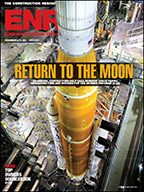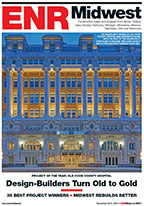 |
| Tom Sawyer |
Tom Sawyer, ENR's information technology editor, covered the war in Iraq last March and April as a journalist embedded with the U.S. Army's Fifth Army Corps. He has returned to revisit the 130th Engineer Brigade as it prepares to rotate back to Germany and to report on the reconstruction effort.
We finally took off from Frankfurt at 6:50 p.m. (18:50just add 12 hours in the afternoon, I keep reminding myself) on a C-17 bound for Balad. Ten passengers sit on jump seats against the wall, five on my side and five maybe 25 feet away on the other side of a pile of cargo. I can see the tops of a couple of peoples heads.
The cargo hold looks like the naked guts of the airplane, curving overhead in a ribbed intestine traced by veins and arteries of wire and pipes and ductwork. The cargo lies uneasily in big, strapped blocks of cardboard boxes, smothered in clear plastic. The hulks shift uneasily with each bump and shudder, stirring on rollers set into the floor. There is no sense of the outdoors. We just zoom and sway in a big metal tube listening to the hissing breath of this monster through our foam plugged ears. It feels like weve been eaten by a huge metal whale. It takes about five and a half hours to get to Balad.
|
We departed from a waiting room whose chairs were filled with tan colored soldiers, rucksacks and duffels, and in a few cases big bundles of rifles all strapped round the middle like large ugly bundles of black asparagus. Security took my pocketknife. It has been locked carefully away.
One fellow with a badge on his breast that said "machine gunner" was anxious about his checked luggage. He was worried about it going out on the wrong plane. "You dont want to end up in a combat zone without your gear, do you," he asked me with a smile. I thought about my little knife.
Im an odd duck in all of this. There are a few civilians traveling with the military, of course, but they seem to have logos on their caps that say things like "DynCorp" and "Raytheon." Logos long associated with the shadow world of military contracting. My hat, after careful consideration, says nothing on it at all.
My travel orders, also, it seems, are strangely mute on some expected point. They seem to be missing some magic something in their curious jargon. They are invitational orders to visit a unit in the field in what is still classified as a combat zone. Officials study them with puzzled expressions, ask in vain for other expected credentials, pass them around for discussion, make a few phone calls and ultimately waive me through. "I dont think these would get you out of Baghdad," one warns darkly. "These wouldnt get you back from Kuwait," says another. "Understood," I reply, although I actually dont. I just count on my hosts to work it out if it comes down to that and soldier on, as they say.
We were two days getting on this bird. Two days of putting our names on lists and dozing in chairs in an Air Force waiting room while scheduled flights mysteriously disappeared from reality, and others showed up just as unexpectedly or soared off apparently without warning for places like Kuwait, Charleston, Dover, Kandahar and Balad. "You just missed one," theyd say. "Theres another one at 16:10, 17:10 and 19:55." Those were called "show times." Passengers are supposed to show up then and see if a plane materialized. Generally they didnt, or if they did, they left inexplicably without passengers.
We were given numerous show times, sent off to get some sleep and called back for more waiting the next day. The flights evaporated from the departure board so often we quit looking at it. We found an army guy with access to a computer who could track tail numbers through the system. Wed check with the air force, get a pretend schedule, and go to the army to see if anything matched up with real airplanes. Those were the ones that got our hopes up. The arrival display on the monitor seemed to be a fictional creation designed to amuse and entertain passengers. Hardly anything on it ever seemed to actually occur.
Our break came late this afternoon today when our names were called for a flight with seats for a lucky 10 passengers. My travel buddies got actual boarding passes and after the usual head scratching over my papers I got one too. They directed us to Departure Lounge 4, which was a room with TV and piped in radio drowning each other out, USO coffee and candy in a table at the front and posters on the walls made by school children thanking the soldiers for protecting them. Our names were called again; we hustled out into the clear, cool air and onto a waiting prison bus for a jaunt down the flight line past a dozen C-17s. There were no actual bars on the prison bus windows. It was just one of those short tin-can things the cops haul perps around in.
Our plane looked like all the others: a squat, hulking gray thing with 4 huge jet mouths and a red strobe light blasting away at the pavement beneath it. We quickly mounted the gangway stairs, claimed jump seats and settled down. An airman climbed atop a cube of cargo with his sample ware and stood where he could see us all lined up along both sides of the plane. Then he instructed us in the use of seatbelts, life vests and oxygen masks that could suddenly appear somehow from the wall behind our heads in a way I could not fathom. Then he showed us a big, clear, orange plastic bag with an oxygen tank on the rear hem that we could put on our heads if the hold filled with smoke or fumes. The exits were at the front and rear and there was a hatch affixed to the wall across the way beside a little sign that said, "Cut here for emergency exit." I checked the wall behind me for similar reassurance and saw the sign above my head, but the little ax was gone. Its things like that that make passengers uneasy.
Five hours to Balad. The fellow just down from me told me hes seen these planes taking off from there decorating the sky with flares spat out from their bellies. The heat from the flares is supposed to distract missiles, he says, making it safer. But we wont be able to see it if our plane does that. You cant see anything from in here. Besides, from what I have been hearing, landing at Balad these days, which is said to be a huge, well protected airfield, must be about as dicey as landing at OHare.
I guess well see.
A note on landing: No idea about the flares. An airman shrugged when I asked. "Sometimes we do, sometimes we dont. All I knew from my seat is that we just made a lot of noise, bumped to the ground and rolled to a stop. When they opened the rear cargo door the familiar smell of garbage dump smoke rolled in. Camps burn their trash. Brought it all back in a whiff. We threw our bags on a little bus and walked about 1,000 yards to a building and road to the gate where our ride picked us up. Behind us we heard a gathering roar as another C-17 cranked up to leave. We could hear it screaming down the runway but couldnt see a thing. I fixed my eye on a light in the distance and was rewarded with a fleeting impression of a huge shape hurtled past as one of the giant planes lifted away without lights.
"Theyre doing the real thing down here," a fellow beside me commented as we walked on toward our bags.




Post a comment to this article
Report Abusive Comment